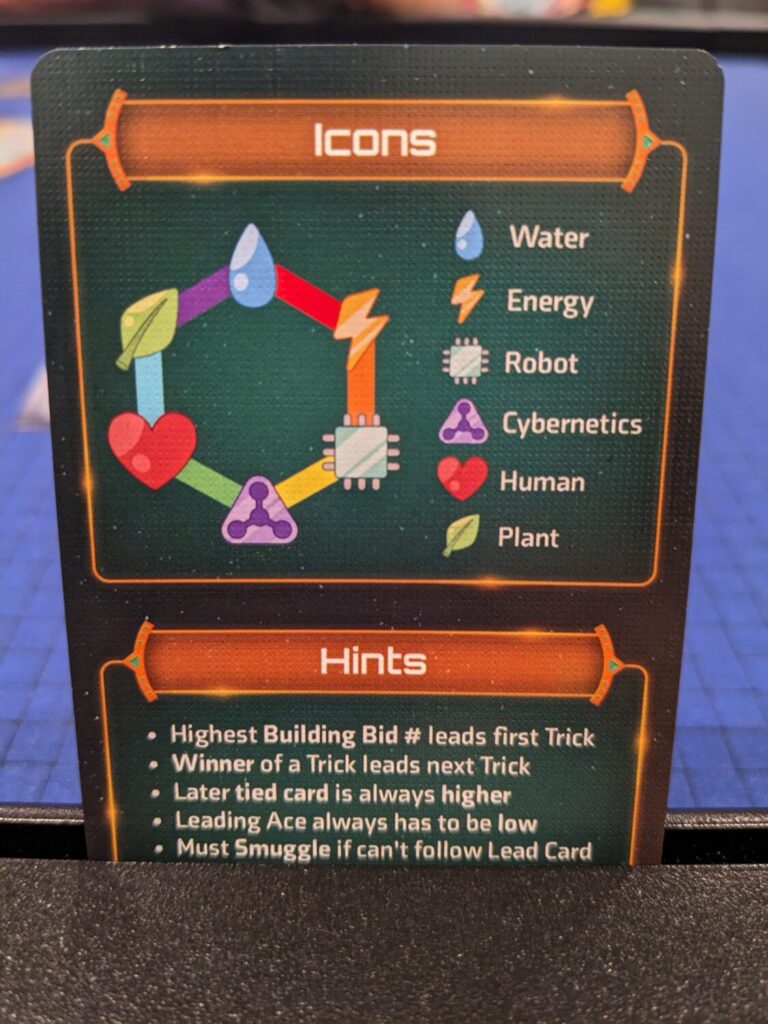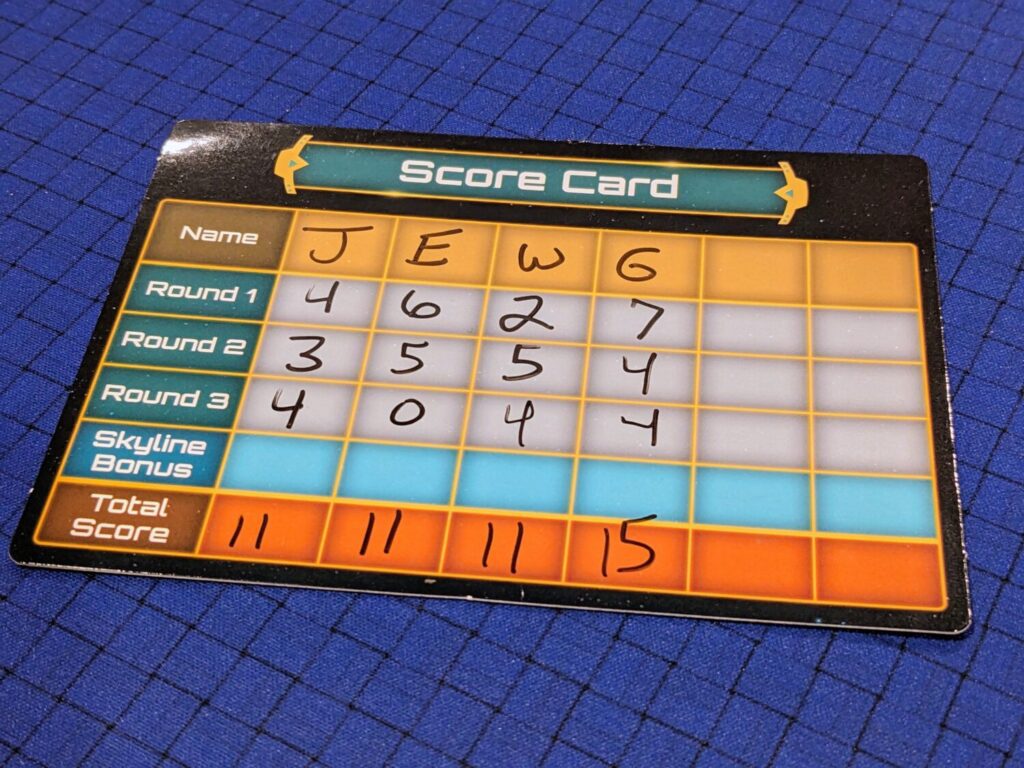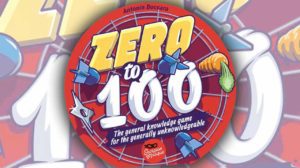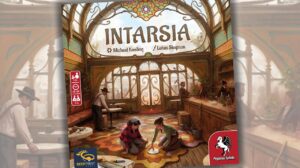Disclosure: Meeple Mountain received a free copy of this product in exchange for an honest, unbiased review. This review is not intended to be an endorsement.
I’ve made a more intentional push in 2025 to get back to reviewing as many card games as I can, for a lot of reasons. I’m a Spades and Hearts man by trade, spending essentially all of my college years playing trick-takers after growing up playing simpler card game endeavors like Crazy Eights, UNO, Rummoli, and Rummy 500. I play a lot of trick-takers but because we have a couple of resident experts here at Meeple Mountain, I often defer to other team members when the review copy phone starts ringing.
Not any more, or at least, not as often. That means I added a few card games to my bag while picking up review copies at Gen Con 2025, and I’ll continue to do that in the months ahead. When I stopped by the Dead Alive Games booth to chat with “man with the plan” Bernie Lin, he handed me a copy of Lunar Skyline.
Here was the surprise: Lunar Skyline is set in the same universe as Dead Alive’s Lunar Rush, but Lunar Rush is definitely not a trick-taking game. However, Lunar Rush IS a bidding game married to a mix of other Eurogame-adjacent mechanics. Carrying the bidding mechanic forward into a trick taker makes sense, and Lunar Skyline is a lot lighter and shorter than Lunar Rush.

On Paper, I Agree with the Word “Electrifying”
Lunar Skyline is a card game for 2-6 players, with a variable number of rounds featured in each play. Like the recent release Jungo, Lunar Skyline lets players decide on the game length, which might be just a single round or maybe three, using the full length of an included dry-erase score card.
Lunar Skyline is so easy to teach that all the game’s rules are included on a double-sided, poker-sized card. (However, some of these rules are confusingly added under the “Hints” section of the player aid; “winner of a trick leads the next trick” is a rule, not a hint!) Players use a hand of cards in each round to first select a number of tricks they expect to win by playing one of those cards as their “Building Bid” for that round. Each card in Lunar Skyline is “double suited”, so instead of just one suit like most card games, cards here come in two suits from a pool of six: water, energy, robot, human, plant, and cybernetic, each with its own easy-to-parse icon.
The highest bidder goes first, then plays any card from hand to the table. Successive players must follow suit if possible, meaning they can play any card from hand that matches at least one of the two led suits. Each card has a number from 1-10, or they are an Ace, with Aces being flexible enough to serve as either low or high for a given suit. (Aces are also the only cards in the game that have a single suit.)
At the end of a trick, whoever has played the highest card wins the trick, then they get to pick which newly-acquired card will rest on top of the stack. That’s important, because players will score most of their points by matching symbols on their trick stacks with the icons on their Building Bid card. The other way to score points is to acquire a Contract Bonus card, which can only be done when a player meets their Building Bid. Contract Bonuses are available from a market, with cards ranging in quality based on the needs of each player, and each player can only get one Contract Bonus per round.
If a player cannot follow suit, they must “Smuggle” any card from their hand. That card is shown to all players, then placed below their Building Bid and added to any previously won tricks in a round. In that way, the Building Bid consists not only of tricks you tried to win, but any other “tricks” you won by Smuggling a card to your player area. Smuggled cards do not affect the current trick, which often means that players might win a trick by only beating another card or two by the end of each round.
Scoring is simple, and quite low. After losing two points for each trick/Smuggled card over the Building Bid, each player scores one point for each icon on top of a trick stack that matches the Building Bid’s card icons, plus any extras for a Contract Bonus. Final game scores in the 10-15 point range are common after three rounds, and obviously much lower when players commit to only playing a single hand.

But in Practice…
Lunar Skyline was interesting. On paper, I was very excited to see this game in action. Maybe I just like the term “double suited.” Maybe I like the fact that the game’s magnetic box cover is used to indicate who the lead player is for a round. Maybe I like the idea of being exact with a card bid, because that’s the only way to both get extra points (crucial in a low-scoring affair) and not go over, which means not triggering any negative two-point issues.
But in the wild, Lunar Skyline never generated those “electrifying” moments. That was especially true when players had a bad card draw, be it with middling numbers (the death knell of games like this—not being able to pass cards, and not being able to get over a draw that includes a hand of mostly threes, fours, and fives) or because their hand was so evenly spread across suits that it was never possible to sluff cards and take Smuggling tricks instead.
In most cases, players did not meet their Building Bids. No one wants to badly underbid a hand, right? If you bid two or three tricks, but take even one extra trick in a game that hits you with a minus two-point penalty to leave your score at only a point, that’s bad, so I found players more likely to bid 4-6 tricks. Because it is possible for tricks to end with everyone “winning” a trick (in a four-player game, it’s entirely possible to have a final turn where the lead player wins naturally, and no one else has the two suits on their remaining cards, forcing them to Smuggle), you can’t even use the time-honored tradition in Spades to math out how many tricks are really left out there, because no one has any idea who is holding which other suited cards.

Counting cards in Lunar Skyline is hard; each icon is paired with two other icons, depending on the card type. That means that all energy cards are either water-energy cards or energy-robot cards, based on the game’s handy icon guide detailing what suit matchups are possible. You may have been dealt three energy icons…but that means that a good number of cards are in the hands of other players, or (in games with less than five players) not in the round at all because they were removed before hands were dealt.
So, it’s hard to plan in Lunar Skyline. The scores are low. Playing last is infinitely better than playing first, because tiebreaker rules here reward playing the same number as the highest played card last to win ties. (If two players play an eight, the eight played later in turn order wins the trick.) A poor deal in even two of a full game’s three rounds is going to leave one player in the dust. Bid cards are played blind, so when everyone reveals their Building Bid card, everyone might be going hard on, say, cybernetics icons in that round, with only one cybernetics Contract Bonus card in the market.
Lunar Skyline was only OK. There were never any “wow” moments or clever play to win tricks, and missing out on Contract Bonuses kept games close but strangely drama-free. In one of my plays, players tied with 11 points each across three rounds. One of the players in that game ended his comments with the word “meh.”
Omicron Protocol, my only other personal experience with Dead Alive’s catalog, was much more interesting and showed off a lot of depth for a tactical miniatures experience. Lunar Skyline is a different beast, certainly, but it enters a massively overcrowded space in the trick-taking genre. It’s hard to recommend Lunar Skyline over many of the other games in this category.












